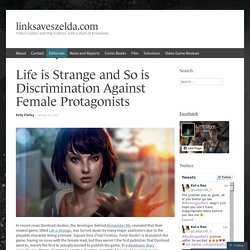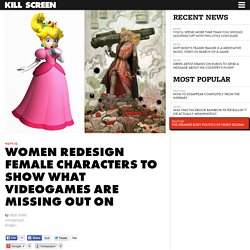

Life is Strange and So is Discrimination Against Female Protagonists. In recent news Dontnod studios, the developer behind Remember Me, revealed that their newest game, titled Life is Strange, was turned down by many major publishers due to the playable character being a female.

Square Enix (Final Fantasy, Tomb Raider) is to publish the game, having no issue with the female lead, but they weren’t the first publisher that Dontnod went to, merely the first to actually wanted to publish the game. In a developer diary Jean-Maxime Morris, Dontnod’s creative director, stated that Square Enix was the only publisher who didn’t want to change a thing about the game; “Square Enix were basically the only publisher who didn’t want to change a single thing about the game. We had other publishers telling us to make it a male lead character, and Square didn’t even question that once.”
“We had some that said, ‘Well, we don’t want to publish it because that’s not going to succeed. Since the dawn of gaming, video games have pandered to a male crowd. So why am I furious? Edward Said. Edward Wadie Said (Arabic pronunciation: [wædiːʕ sæʕiːd]; Arabic: إدوارد وديع سعيد, Idwārd Wadīʿ Saʿīd; 1 November 1935 – 25 September 2003) was a professor of English and Comparative Literature at Columbia University, a literary theorist, and a public intellectual who was a founding figure of the critical-theory field of Post-colonialism.

Born a Palestinian Arab in the city of Jerusalem in Mandatory Palestine (1920–48), he was an American citizen through his father.[3] Said was an advocate for the political and the human rights of the Palestinian people and has been described by the journalist Robert Fisk as their most powerful voice.[4] As a public intellectual, Said discussed contemporary politics and culture, literature and music in books, lectures, and articles.
Biography Early life Edward and his sister Rosemarie (1940) At school Said described his childhood as lived "between worlds", the worlds of Cairo and Jerusalem, until he was twelve.[19] In 1947, he attended the Anglican St. Castrating the Straight Male Gaze on Bayonetta (or at least making room for other ones!) First, a disclaimer: I'm nearly a year late to the party on Bayonetta.

There are several reasons for this, and almost all of them boil down to grad school. I rediscovered the game recently while doing research for my prospectus, stumbling into Chris Dahlen's blog about Bayonetta's sexuality as a weapon. I usually don't dig oversexed vixens for my female characters, but something about Dahlen's piece piqued my curiosity. Black Friday sales made it a good time to purchase the title. My obsession took me through the game in three feverish days, and this behemoth post also emerged in remarkably short order. The Cliff's Notes version of Bayonetta would sound something like the following: an unrealistically proportioned hypersexual witch hunts down angels using magic powered by her hair, which also serves as her primary means of clothing.
Women redesign female characters to show what videogames are missing out on. “Suppose, for instance, that men were only represented in literature as the lovers of women, and were never the friends of men, soldiers, thinkers, dreamers; how few parts in the plays of Shakespeare could be allotted to them; how literature would suffer!

We might perhaps have most of Othello; and a good deal of Antony; but no Caesar, no Brutus, no Hamlet, no Lear, no Jaques—literature would be incredibly impoverished, as indeed literature is impoverished beyond our counting by the doors that have been shut upon women.” - Virginia Woolf, A Room of One's Own When Virginia Woolf was asked to give a series of lectures on the topic of "Women and Fiction," she went straight to the library to research the state of women in literature, only to discover something odd. To sum up her findings, she asked her all-female college audience: “Have you any notion how many books are written about women in the course of one year?
Have you any notion how many are written by men? H/t Tiny Cartridge. Representation of Women in Video Games and How Their Portray by Bridget Wasowski on Prezi. Art imitating life: How sexism in video games mirrors real-life gender imbalance - Comment - Voices - The Independent. It provided an outlet for gamers and game designers alike to express their frustration with the sexism of the gaming industry.

The comments from women working in the industry reflected and repeated many of those we have collected on the Everyday Sexism project, from across a wide variety of jobs and workplaces. Particularly poignant were the stories from women who had been dismissed out of hand before their work had even been seen, or those afraid that a single failure would be deemed “proof that woman shouldn’t be in the industry”. The answer “Because every disclosure of harassment feels like risking never being hired again”, was also achingly familiar. But what really struck home was the similarity, on the #1reasonwhy hashtag and amongst other articles, between gamers’ virtual experiences and the real-life gender imbalance recorded to our project website daily.
The Mary Sue’s Top 15 Video Games of 2014 (With Awesome Lady Representation) Women in gaming: Women make up half of all gamers, but video game characters lag behind. Photo by Robyn Beck/AFP/Getty Images When Microsoft unveiled its brand-new Xbox One console at this week’s E3 convention, Anita Sarkeesian saw more of the same.

Sarkeesian—a longtime critic of gender representation in gaming and a favorite target for harassment for that work—noted that of the 13 new games unveiled for the XBox One, Microsoft presented “exactly zero games featuring a female protagonist for the next generation.” Mou%20Peng.pdf. Video Games And Representation. Researcher examines racial and gender representation in top 50 video games. Violence in video games has been a topic on the political and media radar for decades.

But research conducted by a recent graduate from Ithaca College examines the medium through different lenses: racial and gender bias. Ross Orlando is a lifelong gamer and sociology major with a minor in African diaspora studies. An-examination-of-violence-and-gender-role-portrayals-in-video-games.pdf. Beyond the portrayal of women in video games. Writer Dennis Scimeca argues that the problem of equitable representation of women in video games is just the tip of the iceberg.

In social justice circles a 101-level conversation is the kind of conversation one has with a person who debates the existence of prejudice or inequality. The 101-level conversation is often exhausting because to a social justice activist the problems being addressed are painfully obvious. The Salzburg Academy on Media and Global Change.
Today, newer forms of media such as video games and social platforms are duplicating the traditional media perspective in their depiction of women to some extent by also emphasizing their physical features and reinforcing the notion that they are weaker than men.

Research by Canada’s Center for Digital and Media Literacy finds a correlation between the objectification and victimization of women in video games and violence against them. The study quotes media psychologist Dr. Karen Dill-Shackleford (2011), who states: “When women are consistently shown as sex objects rather than agents, consistently depicted in demeaning and degrading ways, and consistently shown as submissive, the result is to condone and support violence against women, and anti-woman attitudes.” Various organizations like the Women's Campaign Fund, End Violence Against Women and the United Nations have chosen to launch online campaigns to fight objectification and domestic violence.
Heroes and Sex Dolls. The Negative Portrayal of Women in Video Games. The video gaming industry is one that has always been dominated by a mostly male audience.

Just like any industry, the video gaming industry caters to the desires of their most faithful and promising consumers, men. Unfortunately, a large part of catering to the desires of men when it comes to video games, means creating women characters that are sexually objectified and designed to fulfill the fantasies of men. These characters have unnatural bodies and are treated in violent and sexist ways within video games. As Karen Dill discusses in her book, How Fantasy Becomes Reality, women are often used purely for their bodies and to please men sexually and visually within video games. “Women’s sexuality is emphasized: they are sex objects and thus their importance as serving men’s needs is emphasized.” How sexist video game animators keep failing women. The latest Assassins Creed sequel has no playable characters that are women. You'd think it would be simple: just take the framework upon which you build your playable characters and modify it slightly to suit certain gendered characteristics for male and female options.
Sounds easy enough, right? But Ubisoft’s technical director James Therien protested yesterday that the latest installment of Assassin's Creed had no women because it would have “doubled the work” of the animation team. For some perspective, it might be helpful to keep in mind that this is the same gorgeously animated, acclaimed franchise that devotes an entire subset of game play to tree-climbing. Swinging from limb to limb high above the incredibly detailed world? Putting a single woman into an active role in the game?
This isn't even the first time this has happened recently. Grand Theft Auto V is designed deliberately to degrade women. There are three lead characters that players can control in the game: all male. The women characters are often leered at or cast as nags. One of the player characters daughters has “skank” tattooed across her back, one mission has you chaperoning a paparazzo as he tries to photograph an aging actress’s “low-hanging muff.” Portrayal of Women in the Media. By Katherine Walker The world of video games is one in which the role of women has never been clear. As discussed in class, women’s roles in all types of media have been grossly unrecognized, unaccepted and unappreciated. The realm of video gaming is not exclusion to this truth. Women have been marginalized in all types of media, and there are still many areas of media where male dominance is the accepted norm (Class Lecture Slide 3/4/2011).
Gendered Representation in Computer and Videogames. Gendered Representation in Computer and Videogames The main question I will explore here is whether videogames are gender-exclusive, meaning that females cannot gain pleasure from what is essentially a male-dominated environment/activity. I will analyse some examples of games andcharacters that have been successful in appealing to both genders and explore thereasons why it is difficult to find empowering female representations withinvideogames.
I will argue, however, that although it may be true that men and womenmay derive different pleasures from playing videogames, this should not be a reasonto condone the propagation of gender stereotypes.Since the enormous success of Barbie Fashion Designer, which sold over 500,000 copies over two months in 1996 (Cassell and Jenkins 1999;46) manycompanies have tried to cash in on this extremely lucrative girls’ market, with varyingdegrees of success.
Why does sexism persist in the video games industry? - BBC News. Image copyright Ubisoft Is creating female video game characters too much work? That might sound like a rhetorical question, but it was actually one of the main topics of discussion at this year's E3 conference - the video game industry's biggest event, which ended on Thursday. The issue arose after James Therien, technical director at European gamemaker Ubisoft, told trade publication VideoGamer that the latest instalment of Ubisoft hit Assassin's Creed would not feature any playable female characters because it would have "doubled the work". The reaction was swift - and negative - especially when a former Ubisoft developer questioned how much work would be involved. "The message from the industry is that men come first," says Jayd Ait-Kaci, a gamer from Canada who started the hashtag #womenaretoohardtoanimate, which was picked up widely.
Square Enix Tells SJWs To Shut Up With Final Fantasy XV. Final Fantasy: A Demographic Examination. Comparisons. The representation of women in video games. First of all, before starting off this blog post I would like to make several things clear, to abolish the primary “backlash” arguments against what is, admittedly, a controversial topic amongst the gaming community. One can be a fan of things and then go on to criticise their problematic elements – enjoying something is not mutually exclusive of realising a media product has issues, and problems.
Indeed, I enjoy many television shows that have problematic elements (but seen as this is primarily a video game blog I shall not go into those). I can, and do, consider myself a gamer. The Men of Final Fantasy XV Are Making Some Unhappy. How Women Are Represented In Video Games. Damsels In Distress: Female Representation in Video Games.
The first time my brother allowed me to play Mario Kart with him on his Nintendo 64, I immediately selected Princess Peach as my player character. Peach’s shiny hair, princess gloves, and pink dress made me feel as though there was a character just for me in what my brother had made seem was a game just for boys. But as I played the game more I stopped selecting Princess Peach- or any female character. Why the video game industry needs to take the initiative in gender equality. Rather than be gently prompted or decide to get there “some day”, I challenge video game companies to take the lead on instigating a change in their CIS, straight, male privilege-based culture from the inside.
NOW. Welcome to Forbes. Sweden Helping to Destroy Video Game Gender Inequality. Dataspelsbranschen, a game industry trade organization in Sweden, has just been given 272,000 kronor ($36,672) by the European country to look into ways of positively labeling games that promote gender equality. Gender equality is important in gaming - here's why. Sweden considering gender equality label for video games. Swedish game industry trade organisation Dataspelsbranschen is looking to introduce gender equality in video games, by positively labelling new releases that promote equality. The company has been given a 272,000 kronor ($36,672) grant by a Swedish government-funded agency to explore possible ways to better promote those games that are doing their part to promote equality in the industry.
The Males Of Games: Final Fantasy XV's Female Cid. I apologise for not updating in January and I'd be lying if I said that wasn't due to feeling burned out on gender politics in gaming. Since I started this blog, I spent a lot of my time while writing each post seeking out information on the subject, often hunting down as many articles from the gaming media as I could on a particular subject. Talk It Out: Sexism in video games should be considered equal across genders. Tackling the terrible sexism in video games: Women are portrayed as sexual playthings or victims of violence. Adult women make up the largest demographic of gamers, according to a new study released by the Entertainment Software Association.
Naughty Dog Dev: Female Video Game Characters Should be Equal to Men, Not Stronger. Nintendo and it's Female Characters. Historically, video game developers have shyed away from having very much female representation. Video Game Friday: Gender Equality Labeling On Horizon For Video Games Made in Sweden? The gender inequality in core gaming is worse than you think. The Last of Us: How the apocalypse brought about gender equality. Chopping zombies and developing characters in The Walking Dead Episode 4: Amid the Ruins (review) Opinion: Clementine is ruining The Walking Dead Season 2. The Effects of the Sexualization of Female Video Game Characters on Gender Stereotyping and Female Self-Concept. Video games need more women – and asking for that won't end the world. The One-Sided Problem of Oversexualization in Video Games. Video Games and Gender: Game Representation. Gender representation in video games. Once Again, Some Japanese Gamers Dislike the Look of Mirror's Edge 2.
From Lara Croft to Bayonetta: what is a 'strong female character'? Designing Bayonetta « PlatinumGames Inc. Gender in Video Games: There are already strong female characters. Female main characters in videogames.